Project Lifecycle Assessment: Risk Management Analysis
VerifiedAdded on 2021/06/17
|6
|1249
|64
Report
AI Summary
This report provides a detailed analysis of project lifecycle assessment, emphasizing the importance of risk management throughout the project's various phases. It begins by defining the project lifecycle, including conceptualization, planning, execution, and termination phases, and explains how each phase contributes to the overall success of a project. The report highlights the significance of early risk identification and mitigation, emphasizing the potential for unforeseen expenses, technological challenges, and misinterpretations if risk management is neglected. It discusses the different types of risks associated with each stage of the project and the importance of continuous risk management. The report further outlines the essential steps in the risk management process, including risk identification, analysis, evaluation, and the implementation of control measures. It concludes by providing a detailed plan for risk management at each phase of the project lifecycle, emphasizing the benefits of a proactive approach to ensure smooth operations and achieve project goals.

Running head: PROJECT LIFECYCLE ASSESSMENT
Project Lifecycle Assessment
Name of the Student:
Name of the University:
Author Note:
Project Lifecycle Assessment
Name of the Student:
Name of the University:
Author Note:
Paraphrase This Document
Need a fresh take? Get an instant paraphrase of this document with our AI Paraphraser
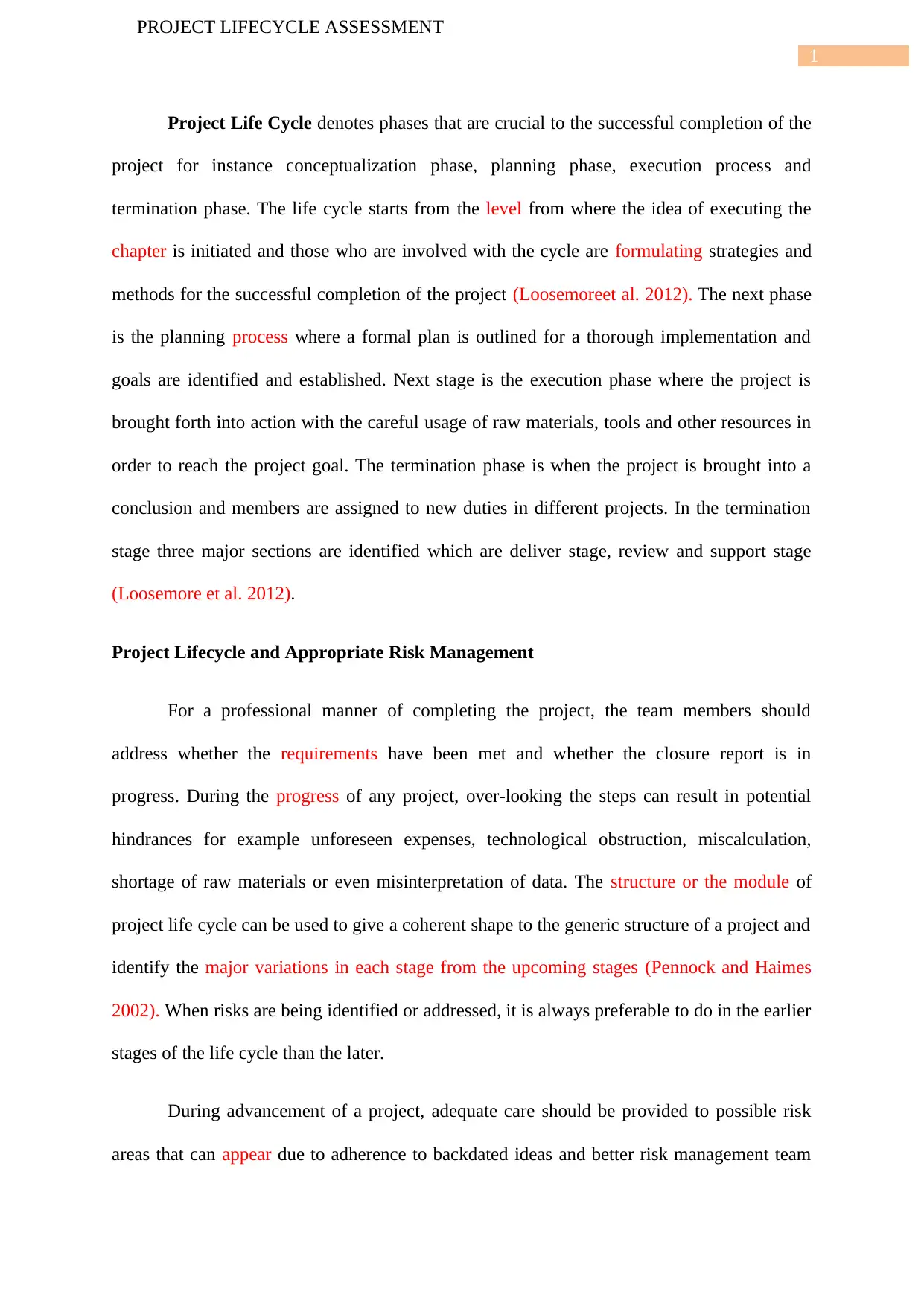
1
PROJECT LIFECYCLE ASSESSMENT
Project Life Cycle denotes phases that are crucial to the successful completion of the
project for instance conceptualization phase, planning phase, execution process and
termination phase. The life cycle starts from the level from where the idea of executing the
chapter is initiated and those who are involved with the cycle are formulating strategies and
methods for the successful completion of the project (Loosemoreet al. 2012). The next phase
is the planning process where a formal plan is outlined for a thorough implementation and
goals are identified and established. Next stage is the execution phase where the project is
brought forth into action with the careful usage of raw materials, tools and other resources in
order to reach the project goal. The termination phase is when the project is brought into a
conclusion and members are assigned to new duties in different projects. In the termination
stage three major sections are identified which are deliver stage, review and support stage
(Loosemore et al. 2012).
Project Lifecycle and Appropriate Risk Management
For a professional manner of completing the project, the team members should
address whether the requirements have been met and whether the closure report is in
progress. During the progress of any project, over-looking the steps can result in potential
hindrances for example unforeseen expenses, technological obstruction, miscalculation,
shortage of raw materials or even misinterpretation of data. The structure or the module of
project life cycle can be used to give a coherent shape to the generic structure of a project and
identify the major variations in each stage from the upcoming stages (Pennock and Haimes
2002). When risks are being identified or addressed, it is always preferable to do in the earlier
stages of the life cycle than the later.
During advancement of a project, adequate care should be provided to possible risk
areas that can appear due to adherence to backdated ideas and better risk management team
PROJECT LIFECYCLE ASSESSMENT
Project Life Cycle denotes phases that are crucial to the successful completion of the
project for instance conceptualization phase, planning phase, execution process and
termination phase. The life cycle starts from the level from where the idea of executing the
chapter is initiated and those who are involved with the cycle are formulating strategies and
methods for the successful completion of the project (Loosemoreet al. 2012). The next phase
is the planning process where a formal plan is outlined for a thorough implementation and
goals are identified and established. Next stage is the execution phase where the project is
brought forth into action with the careful usage of raw materials, tools and other resources in
order to reach the project goal. The termination phase is when the project is brought into a
conclusion and members are assigned to new duties in different projects. In the termination
stage three major sections are identified which are deliver stage, review and support stage
(Loosemore et al. 2012).
Project Lifecycle and Appropriate Risk Management
For a professional manner of completing the project, the team members should
address whether the requirements have been met and whether the closure report is in
progress. During the progress of any project, over-looking the steps can result in potential
hindrances for example unforeseen expenses, technological obstruction, miscalculation,
shortage of raw materials or even misinterpretation of data. The structure or the module of
project life cycle can be used to give a coherent shape to the generic structure of a project and
identify the major variations in each stage from the upcoming stages (Pennock and Haimes
2002). When risks are being identified or addressed, it is always preferable to do in the earlier
stages of the life cycle than the later.
During advancement of a project, adequate care should be provided to possible risk
areas that can appear due to adherence to backdated ideas and better risk management team
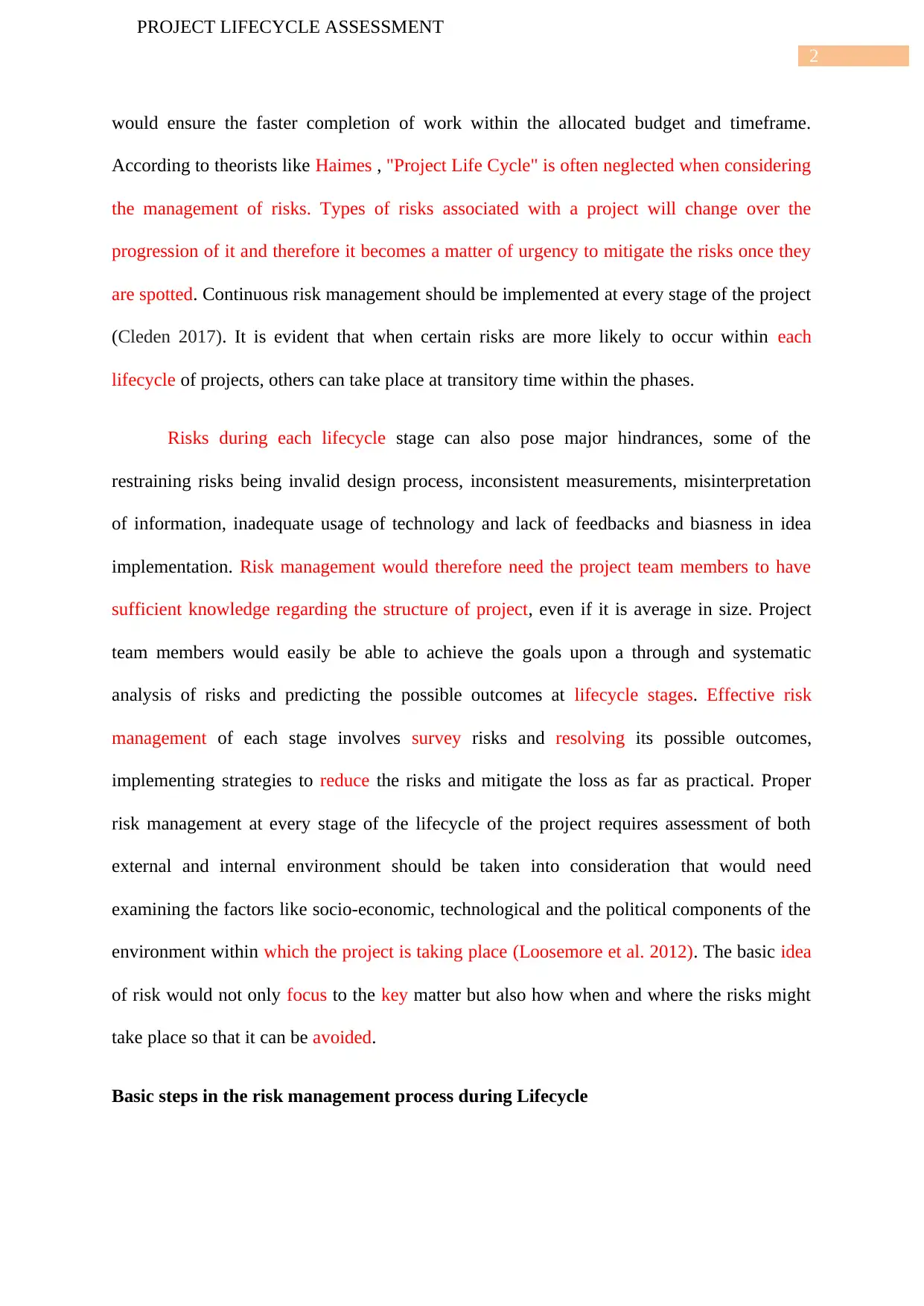
2
PROJECT LIFECYCLE ASSESSMENT
would ensure the faster completion of work within the allocated budget and timeframe.
According to theorists like Haimes , "Project Life Cycle" is often neglected when considering
the management of risks. Types of risks associated with a project will change over the
progression of it and therefore it becomes a matter of urgency to mitigate the risks once they
are spotted. Continuous risk management should be implemented at every stage of the project
(Cleden 2017). It is evident that when certain risks are more likely to occur within each
lifecycle of projects, others can take place at transitory time within the phases.
Risks during each lifecycle stage can also pose major hindrances, some of the
restraining risks being invalid design process, inconsistent measurements, misinterpretation
of information, inadequate usage of technology and lack of feedbacks and biasness in idea
implementation. Risk management would therefore need the project team members to have
sufficient knowledge regarding the structure of project, even if it is average in size. Project
team members would easily be able to achieve the goals upon a through and systematic
analysis of risks and predicting the possible outcomes at lifecycle stages. Effective risk
management of each stage involves survey risks and resolving its possible outcomes,
implementing strategies to reduce the risks and mitigate the loss as far as practical. Proper
risk management at every stage of the lifecycle of the project requires assessment of both
external and internal environment should be taken into consideration that would need
examining the factors like socio-economic, technological and the political components of the
environment within which the project is taking place (Loosemore et al. 2012). The basic idea
of risk would not only focus to the key matter but also how when and where the risks might
take place so that it can be avoided.
Basic steps in the risk management process during Lifecycle
PROJECT LIFECYCLE ASSESSMENT
would ensure the faster completion of work within the allocated budget and timeframe.
According to theorists like Haimes , "Project Life Cycle" is often neglected when considering
the management of risks. Types of risks associated with a project will change over the
progression of it and therefore it becomes a matter of urgency to mitigate the risks once they
are spotted. Continuous risk management should be implemented at every stage of the project
(Cleden 2017). It is evident that when certain risks are more likely to occur within each
lifecycle of projects, others can take place at transitory time within the phases.
Risks during each lifecycle stage can also pose major hindrances, some of the
restraining risks being invalid design process, inconsistent measurements, misinterpretation
of information, inadequate usage of technology and lack of feedbacks and biasness in idea
implementation. Risk management would therefore need the project team members to have
sufficient knowledge regarding the structure of project, even if it is average in size. Project
team members would easily be able to achieve the goals upon a through and systematic
analysis of risks and predicting the possible outcomes at lifecycle stages. Effective risk
management of each stage involves survey risks and resolving its possible outcomes,
implementing strategies to reduce the risks and mitigate the loss as far as practical. Proper
risk management at every stage of the lifecycle of the project requires assessment of both
external and internal environment should be taken into consideration that would need
examining the factors like socio-economic, technological and the political components of the
environment within which the project is taking place (Loosemore et al. 2012). The basic idea
of risk would not only focus to the key matter but also how when and where the risks might
take place so that it can be avoided.
Basic steps in the risk management process during Lifecycle
⊘ This is a preview!⊘
Do you want full access?
Subscribe today to unlock all pages.

Trusted by 1+ million students worldwide
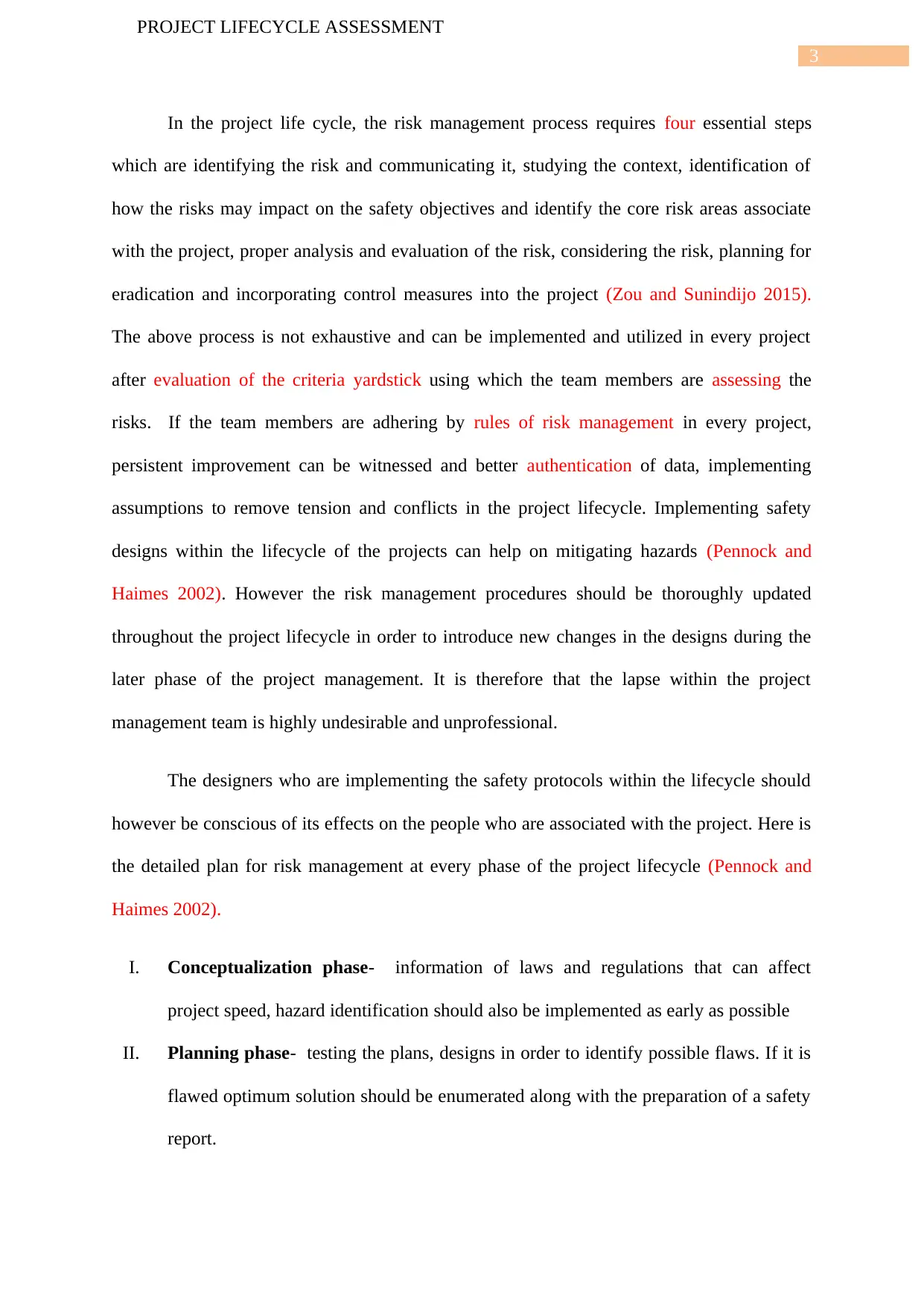
3
PROJECT LIFECYCLE ASSESSMENT
In the project life cycle, the risk management process requires four essential steps
which are identifying the risk and communicating it, studying the context, identification of
how the risks may impact on the safety objectives and identify the core risk areas associate
with the project, proper analysis and evaluation of the risk, considering the risk, planning for
eradication and incorporating control measures into the project (Zou and Sunindijo 2015).
The above process is not exhaustive and can be implemented and utilized in every project
after evaluation of the criteria yardstick using which the team members are assessing the
risks. If the team members are adhering by rules of risk management in every project,
persistent improvement can be witnessed and better authentication of data, implementing
assumptions to remove tension and conflicts in the project lifecycle. Implementing safety
designs within the lifecycle of the projects can help on mitigating hazards (Pennock and
Haimes 2002). However the risk management procedures should be thoroughly updated
throughout the project lifecycle in order to introduce new changes in the designs during the
later phase of the project management. It is therefore that the lapse within the project
management team is highly undesirable and unprofessional.
The designers who are implementing the safety protocols within the lifecycle should
however be conscious of its effects on the people who are associated with the project. Here is
the detailed plan for risk management at every phase of the project lifecycle (Pennock and
Haimes 2002).
I. Conceptualization phase- information of laws and regulations that can affect
project speed, hazard identification should also be implemented as early as possible
II. Planning phase- testing the plans, designs in order to identify possible flaws. If it is
flawed optimum solution should be enumerated along with the preparation of a safety
report.
PROJECT LIFECYCLE ASSESSMENT
In the project life cycle, the risk management process requires four essential steps
which are identifying the risk and communicating it, studying the context, identification of
how the risks may impact on the safety objectives and identify the core risk areas associate
with the project, proper analysis and evaluation of the risk, considering the risk, planning for
eradication and incorporating control measures into the project (Zou and Sunindijo 2015).
The above process is not exhaustive and can be implemented and utilized in every project
after evaluation of the criteria yardstick using which the team members are assessing the
risks. If the team members are adhering by rules of risk management in every project,
persistent improvement can be witnessed and better authentication of data, implementing
assumptions to remove tension and conflicts in the project lifecycle. Implementing safety
designs within the lifecycle of the projects can help on mitigating hazards (Pennock and
Haimes 2002). However the risk management procedures should be thoroughly updated
throughout the project lifecycle in order to introduce new changes in the designs during the
later phase of the project management. It is therefore that the lapse within the project
management team is highly undesirable and unprofessional.
The designers who are implementing the safety protocols within the lifecycle should
however be conscious of its effects on the people who are associated with the project. Here is
the detailed plan for risk management at every phase of the project lifecycle (Pennock and
Haimes 2002).
I. Conceptualization phase- information of laws and regulations that can affect
project speed, hazard identification should also be implemented as early as possible
II. Planning phase- testing the plans, designs in order to identify possible flaws. If it is
flawed optimum solution should be enumerated along with the preparation of a safety
report.
Paraphrase This Document
Need a fresh take? Get an instant paraphrase of this document with our AI Paraphraser
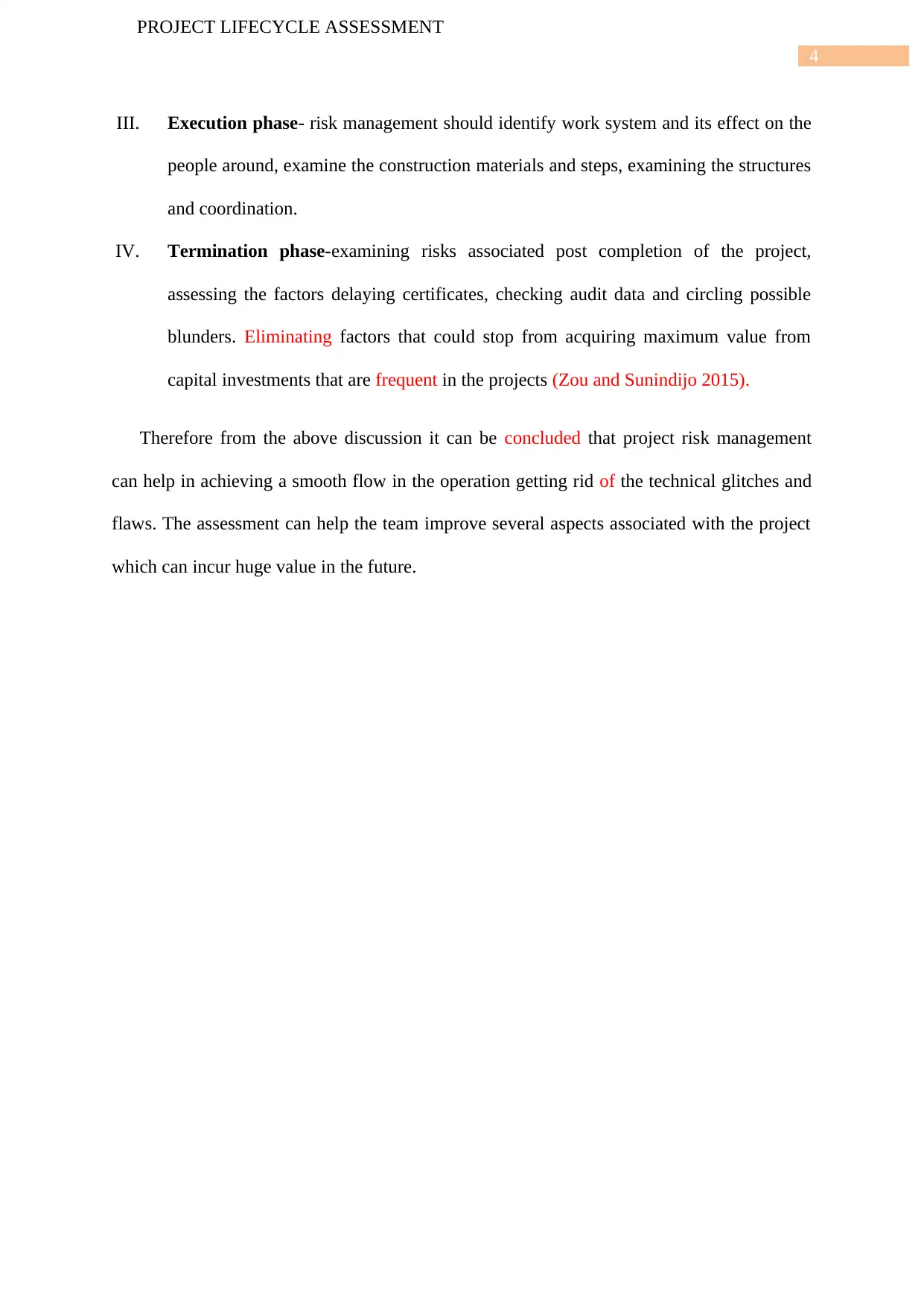
4
PROJECT LIFECYCLE ASSESSMENT
III. Execution phase- risk management should identify work system and its effect on the
people around, examine the construction materials and steps, examining the structures
and coordination.
IV. Termination phase-examining risks associated post completion of the project,
assessing the factors delaying certificates, checking audit data and circling possible
blunders. Eliminating factors that could stop from acquiring maximum value from
capital investments that are frequent in the projects (Zou and Sunindijo 2015).
Therefore from the above discussion it can be concluded that project risk management
can help in achieving a smooth flow in the operation getting rid of the technical glitches and
flaws. The assessment can help the team improve several aspects associated with the project
which can incur huge value in the future.
PROJECT LIFECYCLE ASSESSMENT
III. Execution phase- risk management should identify work system and its effect on the
people around, examine the construction materials and steps, examining the structures
and coordination.
IV. Termination phase-examining risks associated post completion of the project,
assessing the factors delaying certificates, checking audit data and circling possible
blunders. Eliminating factors that could stop from acquiring maximum value from
capital investments that are frequent in the projects (Zou and Sunindijo 2015).
Therefore from the above discussion it can be concluded that project risk management
can help in achieving a smooth flow in the operation getting rid of the technical glitches and
flaws. The assessment can help the team improve several aspects associated with the project
which can incur huge value in the future.
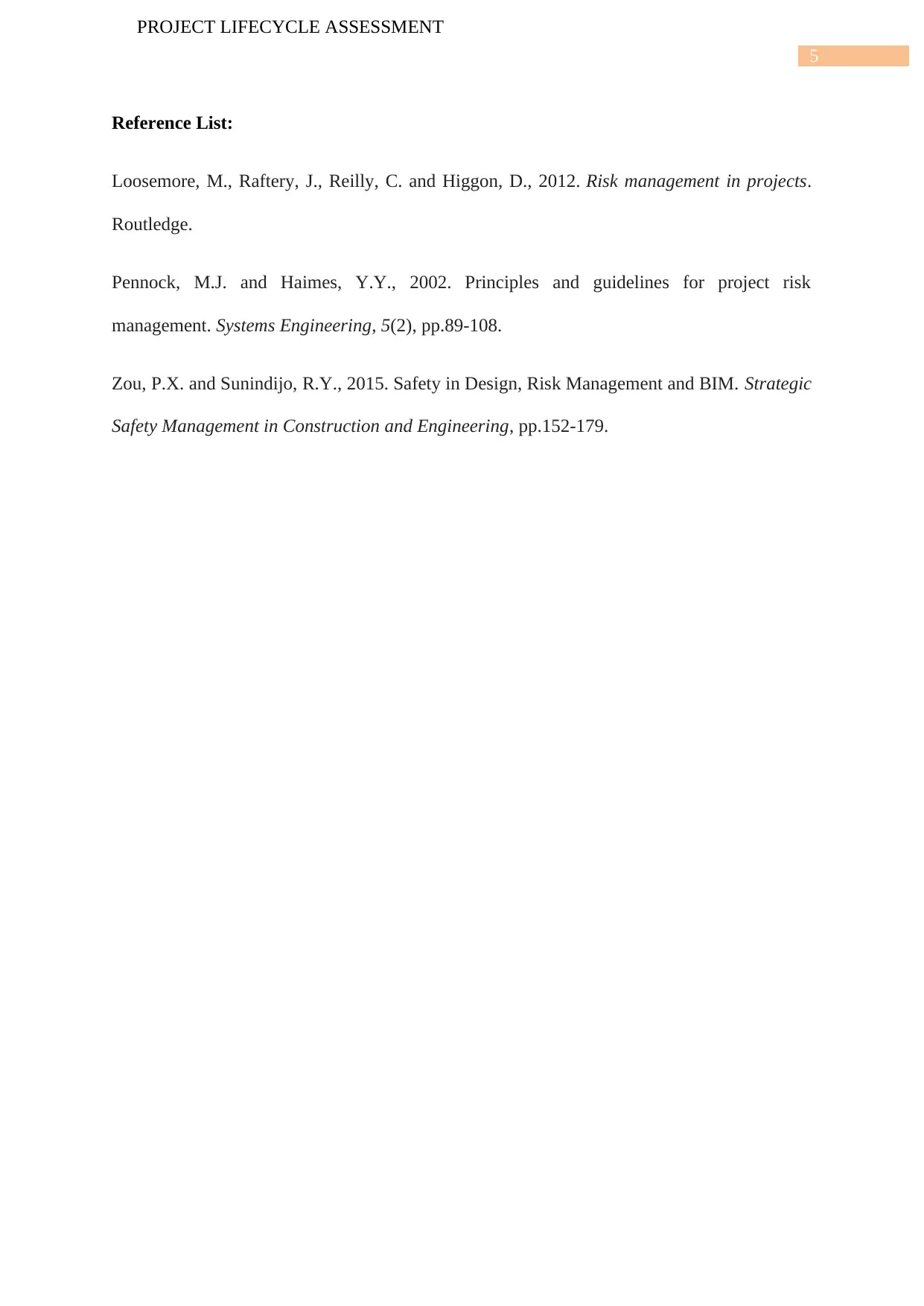
5
PROJECT LIFECYCLE ASSESSMENT
Reference List:
Loosemore, M., Raftery, J., Reilly, C. and Higgon, D., 2012. Risk management in projects.
Routledge.
Pennock, M.J. and Haimes, Y.Y., 2002. Principles and guidelines for project risk
management. Systems Engineering, 5(2), pp.89-108.
Zou, P.X. and Sunindijo, R.Y., 2015. Safety in Design, Risk Management and BIM. Strategic
Safety Management in Construction and Engineering, pp.152-179.
PROJECT LIFECYCLE ASSESSMENT
Reference List:
Loosemore, M., Raftery, J., Reilly, C. and Higgon, D., 2012. Risk management in projects.
Routledge.
Pennock, M.J. and Haimes, Y.Y., 2002. Principles and guidelines for project risk
management. Systems Engineering, 5(2), pp.89-108.
Zou, P.X. and Sunindijo, R.Y., 2015. Safety in Design, Risk Management and BIM. Strategic
Safety Management in Construction and Engineering, pp.152-179.
⊘ This is a preview!⊘
Do you want full access?
Subscribe today to unlock all pages.

Trusted by 1+ million students worldwide
1 out of 6
Related Documents
Your All-in-One AI-Powered Toolkit for Academic Success.
+13062052269
info@desklib.com
Available 24*7 on WhatsApp / Email
![[object Object]](/_next/static/media/star-bottom.7253800d.svg)
Unlock your academic potential
Copyright © 2020–2025 A2Z Services. All Rights Reserved. Developed and managed by ZUCOL.





